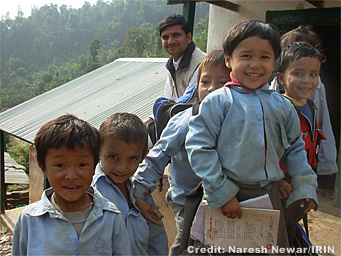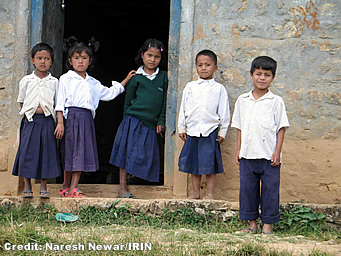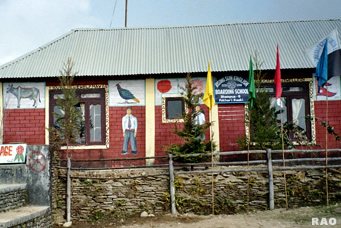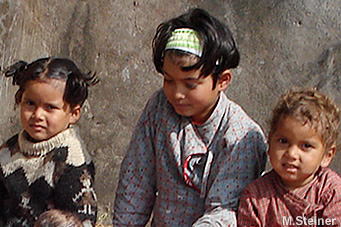|
Education
in Nepal: Reports
|
 |
Nepal EDUCATION |
|
|
 |
|
Schools
identified as key in earthquake preparedness
|
 |
KATHMANDU,
15 October 2007 (IRIN)
Earthquake-resistant
building trainer Balkrishna Kasula is worried that thousands of schools
in seismically active zones throughout the country are poorly built and
vulnerable to earthquakes.
For
the past several decades, Kasula has been involved in rebuilding poorly
built schools and houses to ensure they are more earthquake-resistant,
with the aim of reducing casualties in the event of a strong earthquake.
"There
is no guarantee that anyone or anything is 100 percent safe in a big magnitude
earthquake, but we can at least work towards reducing the [potential] damage,"
Kasula told IRIN.
 |
| According
to the Nepal National Society for Earthquake Technology (NSET) - a major
local civic group involved in earthquake disaster education and seismic
risk reduction projects in Nepal - over a thousand schools in Kathmandu
alone are at risk. None of the surveyed public and private school buildings
complied with the prevailing seismic code, said NSET officials.
"This
is really a worrisome situation given that Nepal ranks as the world's 11th
earthquake risk country," said NSET engineer Ram Adhikary. |
|
He
said his organisation was very alarmed to discover that most buildings
were non-engineered, used traditional weak materials, had untied gable
walls with heavy walls and roofs, and that most were elongated in plan.
Adhikary said this was a recipe for disaster.
"Nepal
has suffered at least 10 big earthquakes in the last 68 years," said Adhikary,
adding that a big one was due any time now, given recent earthquake patterns.
In
1934 a large earthquake killed over 17,000 people in one minute in both
Nepal and the adjoining Indian state of Bihar. Most of those killed were
in Kathmandu, according to NSET, which is concerned that an earthquake
of similar magnitude today could kill over 100,000 people and destroy over
60 percent of the buildings in the capital alone.
| "Schools
- the most important focus" |
 |
 |
| In
the 1988 earthquake in Udaypur District, nearly 400km southeast of Kathmandu,
about 6,000 schools were destroyed, but children were lucky that the earthquake
took place out of school hours, NSET specialists said. Over 300,000 children
had been unable to attend their schools for several months following the
quake.
"Not
all hope is lost and all we have to do is to educate people on the importance
of seismically strengthened buildings and a preparedness plan," said Kasula,
who, along with other trainers from NSET, has trained over 4,000 people
in Nepal. |
|
However,
for disaster safety experts, strengthening school buildings alone cannot
help. There is a need to educate school children and teachers on how to
prepare themselves, they say.
"Schools
remain the most important focus for us since they serve as both shelter
during earthquakes as well as a good medium through which to spread awareness,"
said NSET Director Ram Chandra Kandel, who explained that training and
educating children on preparedness can help to disseminate information
to the community.
"Already,
this methodology is already proving to be quite successful in mass education
through school teachers and students," said Kandel.
| Lack
of awareness |
 |
Experts
are worried that even many educated professionals, including medical personnel,
lack awareness on how to protect themselves in the event of an earthquake.
The concern is that many institutions have no contingency plans regarding
how to respond if thousands of people are injured, roads destroyed and
hospitals overwhelmed.
Earlier
this week, a group of local earthquake disaster preparedness teams tested
a hospital to highlight that lack of preparedness. They staged an incident
by rushing 15-20 "severely injured" patients to a renowned public hospital,
and caused huge panic among doctors who seemed totally unprepared. That
was just an exercise but a lesson for the doctors, who were furious at
first but later appreciated there was a very important lesson to be learned.
 |
| "Our
job is to make sure every resident is absolutely prepared and aware about
earthquakes, as we never know when one might occur. even right now," said
Kandel.
Kandel
gave a shocking scenario of what might happen if the current scale of unpreparedness
were to continue. His technical team said that if the current lack of intervention
- poor education on earthquakes and failure to make schools earthquake-resistant
- were to persist, a major earthquake could kill or severely injure some
29,000 schoolchildren in Kathmandu and destroy over 77 percent of its schools. |
|
Credit
IRIN 2007
Copyright
© UN Office for the Coordination of Humanitarian Affairs 2007
[
This report does not necessarily reflect the views of the United Nations]
Integrated
Regional Information Networks (IRIN), part of the UN Office for the Coordination
of Humanitarian Affairs (OCHA). |
 |
top
| more information
|
 |
| Links |
 |
 |
 |
Externe
Links |
|








